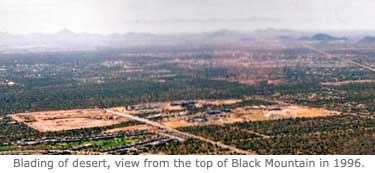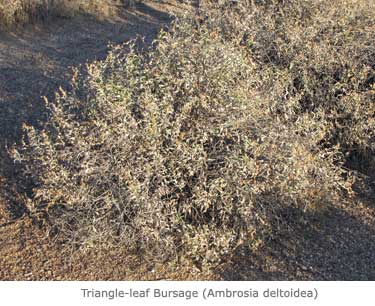BY MARSHALL FANCHER | MAY 11, 2011
When Civilization Encroaches
We benefit when we leave the desert as natural as possible
 As “civilization” encroaches upon the fragile desert, many changes take place, particularly upon land that is zoned for commercial use. A tendency has been observed to clean off land that is put up for sale, destroying the natural vegetation, perhaps with the idea that it will look neater and sell quicker than land left with its natural vegetation intact.
As “civilization” encroaches upon the fragile desert, many changes take place, particularly upon land that is zoned for commercial use. A tendency has been observed to clean off land that is put up for sale, destroying the natural vegetation, perhaps with the idea that it will look neater and sell quicker than land left with its natural vegetation intact.
But please wait a minute, Mr. or Ms. Landowner, and consider the consequences of denuding a piece of land before specific plans are made for its use. See what you may be destroying, and consider how much better it might be to leave the land as it is, at least until its use has been determined and a desert-minded architect has made proposals for its development. Consider the Ironwood and Palo Verde trees. How much would they cost to replace?
Certainly many hundreds of dollars – if it is possible at all. (A nursery grown Ironwood in a 15-gallon pot costs at least $50 and will take many years to reach a mature size.) Consider too, the cost in wildlife habitat and soil erosion when an area is unnecessarily bladed off.
 These are some of the consequences of altering an area from a natural to an artificial state. Stripped-off land quickly loses its thin topsoil to wind and water erosion, creating air pollution and causing runoff rather than retaining water that may replenish the aquifer. (Have you not noticed that even quite steep hillsides with natural vegetation retain most of the rainfall, and that most runoff occurs on roads and other denuded areas?) In disturbed soil it is the seeds of weeds that germinate most readily, with desert broom, tumbleweed, fiddleneck, and ragweed quickly dominating the area. Without natural vegetation, the ground itself becomes hotter in summer and colder in winter. Hungry wildlife, deprived of a natural food supply, is quickly attracted to a yard’s plantings that they might otherwise leave alone. Most young cacti, especially infant saguaros, are vulnerable to dehydration and sunburn, and to freezing in cold weather, if deprived of shade. Evaporation is accelerated and shallow roots are destroyed. Even large saguaros suffer when ground cover is removed from their shallow root systems.
These are some of the consequences of altering an area from a natural to an artificial state. Stripped-off land quickly loses its thin topsoil to wind and water erosion, creating air pollution and causing runoff rather than retaining water that may replenish the aquifer. (Have you not noticed that even quite steep hillsides with natural vegetation retain most of the rainfall, and that most runoff occurs on roads and other denuded areas?) In disturbed soil it is the seeds of weeds that germinate most readily, with desert broom, tumbleweed, fiddleneck, and ragweed quickly dominating the area. Without natural vegetation, the ground itself becomes hotter in summer and colder in winter. Hungry wildlife, deprived of a natural food supply, is quickly attracted to a yard’s plantings that they might otherwise leave alone. Most young cacti, especially infant saguaros, are vulnerable to dehydration and sunburn, and to freezing in cold weather, if deprived of shade. Evaporation is accelerated and shallow roots are destroyed. Even large saguaros suffer when ground cover is removed from their shallow root systems.
 Consider for a moment the great value of the most common desert plant, the lowly burr sage (also known as bursage). This is one of the least appreciated and yet most valuable of the desert plants. It serves as a ground insulator in both summer and winter, retards wind and water erosion, provides shelter for wildlife and food for them as well when drought conditions make other plants less plentiful. It provides a mulching function as dead leaves fall off and become part of the soil, resulting in a softer ground into which small animals can burrow. It is essential to the reproduction of many cacti, especially saguaros that must have shade for several years if they are to survive. It offers protection from predators and raptors for many small animals and quail, and provides the vitamins quail need for reproduction.
Consider for a moment the great value of the most common desert plant, the lowly burr sage (also known as bursage). This is one of the least appreciated and yet most valuable of the desert plants. It serves as a ground insulator in both summer and winter, retards wind and water erosion, provides shelter for wildlife and food for them as well when drought conditions make other plants less plentiful. It provides a mulching function as dead leaves fall off and become part of the soil, resulting in a softer ground into which small animals can burrow. It is essential to the reproduction of many cacti, especially saguaros that must have shade for several years if they are to survive. It offers protection from predators and raptors for many small animals and quail, and provides the vitamins quail need for reproduction.
Why scrape it off before plans are made for the land? Do you honestly feel that bare dirt looks better than natural desert vegetation? We know that changes will come, but please, let them come in an orderly planned way that respects the desert rather than destroys it.
Photos by Dave Mills



